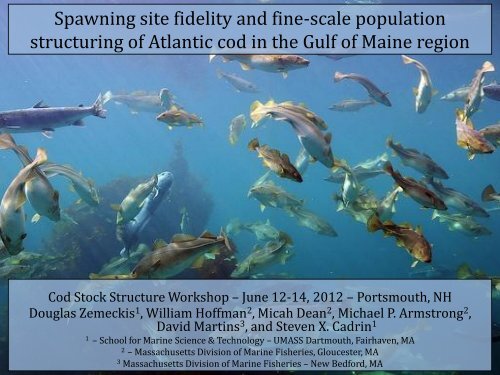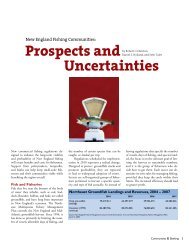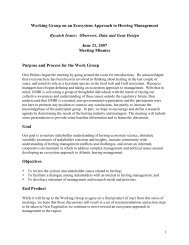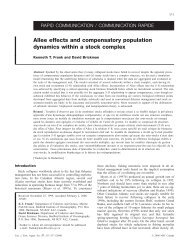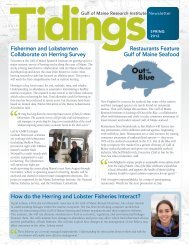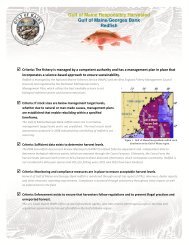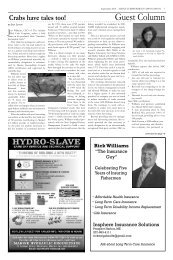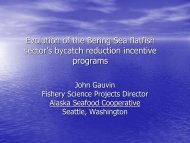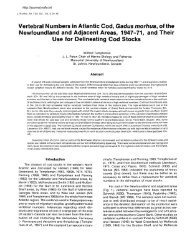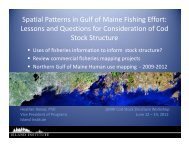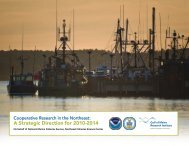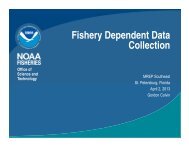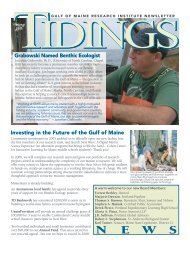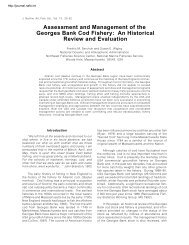Presentation - Gulf of Maine Research Institute
Presentation - Gulf of Maine Research Institute
Presentation - Gulf of Maine Research Institute
You also want an ePaper? Increase the reach of your titles
YUMPU automatically turns print PDFs into web optimized ePapers that Google loves.
Spawning site fidelity and fine-scale population<br />
structuring <strong>of</strong> Atlantic cod in the <strong>Gulf</strong> <strong>of</strong> <strong>Maine</strong> region<br />
Cod Stock Structure Workshop – June 12-14, 2012 – Portsmouth, NH<br />
Douglas Zemeckis 1 , William H<strong>of</strong>fman 2 , Micah Dean 2 , Michael P. Armstrong 2 ,<br />
David Martins 3 , and Steven X. Cadrin 1<br />
1<br />
– School for Marine Science & Technology – UMASS Dartmouth, Fairhaven, MA<br />
2<br />
– Massachusetts Division <strong>of</strong> Marine Fisheries, Gloucester, MA<br />
3<br />
Massachusetts Division <strong>of</strong> Marine Fisheries – New Bedford, MA
Introduction<br />
• Common assessment techniques and management strategies assume<br />
discrete populations, but management units are typically heterogeneous<br />
and consist <strong>of</strong> multiple sub-units (Stephenson 1999).<br />
• Metapopulation structuring has been documented within cod management<br />
units <strong>of</strong>f Newfoundland (e.g., Rose et al. 2011), Iceland (e.g., Jonsdottir et al.<br />
2007), Scotland (e.g., Wright et al. 2006), and Norway (e.g., Sarvas and<br />
Fevolden 2005).<br />
– Growing evidence <strong>of</strong> complex population structuring in U.S. waters<br />
Tagging, genetics, spawning behavior, larval dispersal, growth rates,<br />
morphometry, and productivity patterns (e.g., Runge et al. 2010).<br />
• Maintenance <strong>of</strong> spawning diversity is critical for sustaining a robust stock.<br />
– Reduce likelihood <strong>of</strong> recruitment failure (match/mismatch hypothesis)<br />
– Maintain stock productivity and stability
Stock structure in the <strong>Gulf</strong> <strong>of</strong> <strong>Maine</strong> region<br />
• Ames (2004) identified four historic subpopulations based upon 1920’s<br />
data and surveys from retired fishermen.<br />
• Each subpopulation had discrete migration corridors, local cyclical<br />
movements, and partial isolation due to bathymetry.<br />
• Clusters <strong>of</strong> spawning components were identified within each<br />
subpopulation.
Stock structure in the <strong>Gulf</strong> <strong>of</strong> <strong>Maine</strong> region<br />
• Nearly half <strong>of</strong> the historic spawning components appear to be inactive,<br />
due to overfishing, coastal pollution, and declines <strong>of</strong> forage species<br />
(Ames 2004).<br />
– System-wide assessments appear to be unable to detect gradual erosion <strong>of</strong><br />
spawning components.<br />
– Inactive spawning sites have not become re-populated once abandoned.<br />
Ames (2004)
Fine-scale population structuring<br />
• Potential mechanisms contributing to fine-scale population structuring:<br />
• Restricted dispersal during early life stages<br />
• Temporal variation in spawning<br />
• Differences in spawning habitat<br />
• Divergent trophic ecology<br />
• Spawning site fidelity<br />
– Return to the same spawning site each year<br />
• Natal homing<br />
– Inferences regarding location where spawned<br />
Wroblewski et al. (2005)
Spawning site fidelity <strong>of</strong> Atlantic cod<br />
• Robichaud and Rose (2001) investigated the degree <strong>of</strong> multi-year fidelity to the<br />
Bar Haven spawning ground in Placentia Bay, Newfoundland.<br />
• A total <strong>of</strong> 48 cod were tagged in 1998.<br />
• Fish were monitored using active tracking<br />
during subsequent spawning seasons.<br />
• All relocated fish were within 10km <strong>of</strong><br />
spawning site (most
Spawning site fidelity <strong>of</strong> Atlantic cod<br />
• Robichaud and Rose (2001) documented straying in cod that were<br />
unobserved during the spawning season.<br />
– Potential genetic exchange among adjacent populations.<br />
• A life history balance appears to exist between homing and straying that<br />
maintains population stability, while permitting recolonization <strong>of</strong><br />
inactive spawning sites.<br />
– Accurate and prevalent homing would impede rapid recolonization.
Spawning site fidelity <strong>of</strong> Atlantic cod<br />
• Skjaeraasen et al. (2011) studied cod on their coastal spawning ground <strong>of</strong>f<br />
western Norway in 2007 using acoustic telemetry.<br />
• Unadjusted rates <strong>of</strong> spawning site fidelity <strong>of</strong> at least 55% and 37% were<br />
observed in 2008 and 2009, respectively.<br />
– ‘Extremely’ fine-scale (
Spawning cod in the <strong>Gulf</strong> <strong>of</strong> <strong>Maine</strong><br />
• Cod in the <strong>Gulf</strong> <strong>of</strong> <strong>Maine</strong> have been suggested to demonstrate spawning<br />
site fidelity/homing behavior based upon conventional tagging data:<br />
– Perkins et al. (1997): Sheepscot Bay, <strong>Maine</strong><br />
– Howell et al. (2008): Ipswich Bay spring spawners
Spawning cod in the <strong>Gulf</strong> <strong>of</strong> <strong>Maine</strong><br />
• Sicel<strong>of</strong>f and Howell (in press) used<br />
stationary receivers and active tracking<br />
to study spawning cod in Ipswich Bay<br />
during the spring <strong>of</strong> 2006.<br />
– Active tracking for 39 days (5/6 – 6/30)<br />
– Ten stationary receiver stations
Spawning cod in the <strong>Gulf</strong> <strong>of</strong> <strong>Maine</strong><br />
• Most cod aggregated around raised<br />
bathymetric features Whaleback<br />
• Individuals were typically active in<br />
areas ranging from approximately<br />
17-57 km 2 (mean area <strong>of</strong> 41 km 2 ).<br />
• Residence time: 8 - 54 + d (mean= 30 d)<br />
• Demonstrates that cod spawning<br />
activity occurs over relatively finescales.<br />
Potential isolation mechanism leading<br />
to fine-scale population structuring.<br />
Individual kernel distribution estimations<br />
(95% volume contours)
Spawning cod in the <strong>Gulf</strong> <strong>of</strong> <strong>Maine</strong><br />
• Zemeckis et al. (in progress) have been studying spawning cod in<br />
northern Massachusetts Bay since 2009.<br />
– Spring Cod Conservation Zone (SCCZ): Closed annually April 16 – July 21
Spawning cod in the <strong>Gulf</strong> <strong>of</strong> <strong>Maine</strong><br />
• Cod were monitored on the spawning site using a stationary Vemco<br />
VR2W Positioning System (VPS).<br />
• Acoustic transmitters have been released annually since 2009.<br />
– 2009: n = 7<br />
– 2010: n = 52<br />
– 2011: n = 4<br />
– 2012: in progress
Spawning cod in the <strong>Gulf</strong> <strong>of</strong> <strong>Maine</strong><br />
Spawning site fidelity : 2009 Releases<br />
• Three <strong>of</strong> the seven fish tagged in 2009 returned to the spawning site in<br />
2010 (43%).<br />
– Two <strong>of</strong> these same fish also returned in 2011.<br />
– One <strong>of</strong> which has also returned in 2012.<br />
• Documentation <strong>of</strong> extremely fine-scale (
Spawning cod in the <strong>Gulf</strong> <strong>of</strong> <strong>Maine</strong><br />
Spawning site fidelity : 2010 Releases<br />
• A total <strong>of</strong> 15 <strong>of</strong> the 52 cod tagged in 2010 returned to the spawning site in 2011.<br />
Unadjusted rate <strong>of</strong> 29%<br />
• A total <strong>of</strong> 13 <strong>of</strong> the 52 cod tagged in 2010 were recovered in the fishery.<br />
25% minimum fishing mortality rate<br />
20% natural mortality<br />
• Adjusted rate <strong>of</strong> spawning site fidelity = 74%<br />
– Does not account for skipped spawning or tag failure rate, and includes a minimum<br />
rate <strong>of</strong> observed fishing mortality (tag non-reporting rate).<br />
• Residence times in 2011 ranged from 4 - 106 days (mean = 36 days).<br />
• At least four fish have returned in 2012 to confirm multi-year fidelity.
Spawning cod in the <strong>Gulf</strong> <strong>of</strong> <strong>Maine</strong><br />
• Evidence <strong>of</strong> connectivity among<br />
coastal spawning sites:<br />
• < 100% adjusted rate <strong>of</strong> spawning<br />
site fidelity<br />
• Tag recaptures from other spawning<br />
sites: Whaleback & Eagle Ridge<br />
• 2012 acoustic telemetry data<br />
• Connectivity among coastal spring<br />
spawning sites corroborates genetic<br />
findings (Kovach et al. 2010).<br />
• Rates <strong>of</strong> recolonization are expected<br />
to be low given the prevalent<br />
homing behavior.<br />
Recapture locations <strong>of</strong> SCCZ tag releases
Synthesis <strong>of</strong> Stock Structure<br />
• The expression <strong>of</strong> spawning site fidelity supports the hypothesis <strong>of</strong> complex<br />
population structuring and significant intra-stock diversity in the <strong>Gulf</strong> <strong>of</strong><br />
<strong>Maine</strong> region.<br />
• The biological stock structure in the <strong>Gulf</strong> <strong>of</strong> <strong>Maine</strong> region is reflective <strong>of</strong> a<br />
metapopulation.<br />
– Multiple spawning components that experience partially independent dynamics<br />
with some degree <strong>of</strong> connectivity.<br />
• The fine-scale population structuring is not consistent with the current largescale<br />
management units that assume discrete populations.<br />
– Threat <strong>of</strong> continued declines in spawning diversity<br />
– Continued difficulties in rebuilding are expected<br />
• Potential management options include restricted fishing during the spawning<br />
season (e.g., spawning closures) and trip limits to prevent the extirpation <strong>of</strong><br />
additional spawning components.
Future <strong>Research</strong><br />
• The following research is required to better inform recommendations<br />
on the most likely stock structure in the <strong>Gulf</strong> <strong>of</strong> <strong>Maine</strong> region:<br />
– Documentation <strong>of</strong> spawning site fidelity in other locations<br />
– Further investigation <strong>of</strong> fine-scale spawning behavior<br />
– Investigation <strong>of</strong> the connectivity among spawning sites<br />
– Identifying potential mechanisms for the recolonization <strong>of</strong> inactive<br />
spawning sites<br />
– Determining the effectiveness <strong>of</strong> spawning closures<br />
– Studying the seasonal migration patterns <strong>of</strong> each spawning<br />
component
Acknowledgments<br />
• This research has been funded in part by the US Fish and<br />
Wildlife Services through the Sportfish Restoration Act, and the<br />
Massachusetts Marine Fisheries <strong>Institute</strong> (MFI).
References<br />
Ames, E.P. 2004. Atlantic cod stock structure in the <strong>Gulf</strong> <strong>of</strong> <strong>Maine</strong>. Fisheries 29(1), 10-28.<br />
Howell, W.H., Morin, M., Rennels, N., and Goethel, D. 2008. Residency <strong>of</strong> adult Atlantic cod (Gadus morhua) in the<br />
western <strong>Gulf</strong> <strong>of</strong> <strong>Maine</strong>. Fisheries <strong>Research</strong> 91, 123-132.<br />
Jonsdottir, I. G., G. Marteinsdottir and S. E. Campana. 2007. Contribution <strong>of</strong> diverent spawning components to the<br />
mixed stock fishery for cod in Icelandic waters. ICES Journal <strong>of</strong> Marine Science, 64: 1749-1759.<br />
Kovach, A.I., Breton, T.S., Berlinsky, D.L., Maceda, L., and Wirgin, I. 2010. Fine-scale spatial and temporal genetic<br />
structure <strong>of</strong> Atlantic cod <strong>of</strong>f the Atlantic coast <strong>of</strong> the USA. Marine Ecology Progress Series 410, 177-195.<br />
Perkins, H.C., Chenoweth, S.B., and Langton, R.W. 1997. The <strong>Gulf</strong> <strong>of</strong> <strong>Maine</strong> Atlantic cod complex, patterns <strong>of</strong><br />
distribution and movement <strong>of</strong> the Sheepscot Bay substock. Bull. Natl. Res. Inst. Aquacult. Suppl. 3, 101-107.<br />
Robichaud, D. and Rose, G.A. 2001. Multiyear homing <strong>of</strong> Atlantic cod to a spawning ground. Can. J. Fish. Aquat. Sci.<br />
58, 2325-2329.<br />
Rose, G.A., Nelson, R.J., and Mello, L.G.S. 2011. Isolation or metapopulation: whence and whither the Smith Sound<br />
cod?. Canadian Journal <strong>of</strong> Fisheries and Aquatic Sciences 68, 152-169.
References<br />
Runge JA, A Kovach, J Churchill, L Kerr, JR Morrison, R Beardsley, D Berlinsky, C Chen, S Cadrin, C Davis, K<br />
Ford, JH Grabowski, WH Howell, R Ji, R Jones, A Pershing, N Record, A Thomas, G Sherwood, S Tallack<br />
& D Townsend 2010 Understanding Climate Impacts on Recruitment and Spatial Dynamics <strong>of</strong> Atlantic<br />
Cod in the <strong>Gulf</strong> <strong>of</strong> <strong>Maine</strong>: Integration <strong>of</strong> Observations and Modeling. Progress in Oceanography 87:<br />
251–263.<br />
Sarvas, T. H. and S.-E. Fevolden. 2005. Pantophysin (Pan I) locus divergence between inshore v. <strong>of</strong>fshore<br />
and northern v. southern populations <strong>of</strong> atlantic cod in the north-east atlantic. Journal <strong>of</strong> Fish Biology,<br />
67: 444{469. DOI: 10.1111/j.1095-8649.2005.00738.x.<br />
Sicel<strong>of</strong>f, L. and Howell, H. In press. Fine-scale temporal and spatial distributions <strong>of</strong> Atlantic cod (Gadus<br />
morhua) on a western <strong>Gulf</strong> <strong>of</strong> <strong>Maine</strong> spawning ground. Fisheries <strong>Research</strong>.<br />
http://dx.doi.org/10.1016/j.fishres.2012.04.001.<br />
Skjaeraasen, J.E., Meager, J.J., Karlsen, O., Hutchings, J.A., and Ferno, A. 2011. Extreme spawning-site fidelity<br />
in Atlantic cod. ICES Journal <strong>of</strong> Marine Science 68(7), 1472-1477.<br />
Stephenson, R.L. 1999. Stock complexity in fisheries management: a perspective <strong>of</strong> emerging issues<br />
related to population sub-units. Fisheries <strong>Research</strong> 43, 247-249.<br />
Wright, P.J., Neat, F.C., Gibb, F.M., Gibb, I.M., and Thordarson, H. 2006. Evidence for metapopulation<br />
structuring in cod from the west Scotland and North Sea. Journal <strong>of</strong> Fish Biology 69 (Suppl. C), 181-<br />
199.


